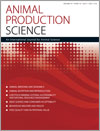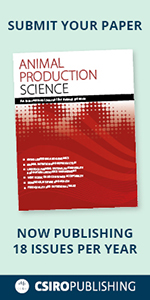
Animal Production Science
Volume 53 Number 10 2013
AN12009Interactions between piglet weaning age and dietary creep feed composition on lifetime growth performance
The provision of creep feed to piglets before weaning aims to reduce the post weaning growth check and improve lifetime performance. This study examined the interactions between creep feed composition and weaning age, with the results suggesting a complex creep diet offered during lactation may not improve performance above that of a less expensive creep diet. Weaning age appears to have a greater influence on lifetime performance of the pig.
AN12364The kinetics of starch and nitrogen digestion regulate growth performance and nutrient utilisation of broilers fed coarsely ground, sorghum-based diets
An ideal dietary balance of protein and energy is required for efficient chicken-meat production. The influence of nitrogen and starch digestion kinetics on the performance of broiler chickens was investigated; it was found that rates of digestion were more important than extents of digestion. To enhance broiler performance there should be a greater focus on relative rates of protein and energy digestion.
AN12161Dietary arginine from 15 to 35 days of age affects feed intake and carcass yield in White Pekin ducks
Increasing feed intake and meat yield of duck are expected in duck industry. Dietary arginine supplementation stimulated appetite without changing the concentrations of neuropeptide Y or leptin in hypothalamus, and promoted muscle growth in ducks of both sexes. The findings will assist in the development of a feeding strategy to enhance feed utilisation efficiency and lean-tissue growth in ducks.
AN12302Growth performance and intestinal morphology in broiler chickens produced from hyperthyroid breeder hens
The maintenance of growth performance has always been a major challenge for ascites-attenuating approaches, including maternal hyperthyroidism in broiler production. This experiment, which aimed to study the effect of maternal hyperthyroidism on growth performance and intestinal morphology in progeny chicks, showed no association between maternal treatment and traits evaluated. Accordingly, maternal hyperthyroidism may find an application to improve broiler production.
AN12183Comparison of ryegrass and red clover on the fermentation pattern, microbial community and efficiency of diet utilisation in the rumen simulation technique (Rusitec)
Balancing energy and nitrogen in the rumen is essential for the optimisation of ruminant diets. Our in vitro findings indicated that red clover provides an excess of rumen-degradable nitrogen, which leads to a lower efficiency of nitrogen utilisation by the rumen microorganisms than observed in ryegrass diets. As a result, red clover grazing may increase nitrogen pollution compared with ryegrass without substantial improvement to rumen function.
AN12301Efficacy, persistence and presence of Synergistes jonesii in cattle grazing leucaena in Queensland: on-farm observations pre- and post-inoculation
University of Queensland research has demonstrated that fermenter produced inoculum may not provide fully effective long-term protection against leucaena toxicity. The study was conducted on 8 properties in southeast Queensland where cattle grazed leucaena and were exposed to high toxin levels as indicated by urinary analysis. Nevertheless, it was recommended that graziers continue to use the inoculum until more effective inoculation strategies become available. However, they should test their herds yearly using the colorimetric urine test and re-inoculate if necessary to ensure that their animals are not exposed to toxicity.
AN12435Genetic relationships between live animal scan traits and carcass traits of Australian Angus bulls and heifers
Ultrasound scanning of live animal body composition allows prediction of future carcass quality, and, therefore, Australian Angus breeders can select high performing young animals for breeding early in life. The reliability of the predictions depends on the genetic correlation between scanned body and carcass composition and is not affected by the age of the scanned individuals. Thus, the age of the individuals at scanning can be decreased without decreasing accuracy of genetic evaluation.
AN12305Genetics of early conception and its relationship to growth traits in red deer (Cervus elaphus)
Data were analysed from five seasonally mated herds of red deer in New Zealand, to evaluate the genetics of early conception success (date) and liveweight. Hinds ranked similarly alongside their herd-mates for conception date from one season to another. Conception date was inherited. Selection for earlier conception was associated genetically with increases in weaning and yearling weights.
AN12178Genetic effects of polymorphisms in the prolactin receptor gene on chicken reproductive traits
Our study highlights the affects of PRLR mutations on egg reproduction traits. Five SNPs were identified in the chicken PRLR gene. The results suggest that the single-nucleotide polymorphism g.-14A > G at P1 locus could be a potential genetic marker for age at first egg and number of eggs at 300 days of age.
AN12269Annual lambing performance of crossbred ewes in out-of-season and accelerated lamb production systems
An 8-monthly accelerated lambing system significantly increased annual lamb production from crossbred ewes. The average annual lamb production from two genotypes of crossbred ewes was evaluated in three lamb production systems (accelerated 8-monthly, spring joining with an autumn backup and annual autumn joining). An accelerated lambing system is likely to be more successful using ewes that naturally have an extended breeding season and good out-of-season breeding performance.
AN12193Transient treatment of pregnant Merino ewes with modulators of cortisol biosynthesis coinciding with primary wool follicle initiation alters lifetime wool growth
Lifetime characteristics of wool, such as fibre diameter, are determined during distinct periods in utero. The aim of this study was to determine if transient manipulation of maternal cortisol status could alter the fleece characteristics of Merino sheep. We demonstrated that treatment with an inhibitor of cortisol biosynthesis, metyrapone, during the first wave of fetal wool follicle development significantly increased the hairiness of lambs and the fibre lengths of adult sheep, hence indicating that improvements in fleece characteristics can occur by alteration of the maternal environment.
AN12335Evaluation of an electronic system for automatic calving detection on a dairy farm
Calving monitoring is fundamental for reducing effects of dystocia in cows and calves. An electronic device for detecting the exact moment of the expulsion phase was tested on a dairy farm. In 100% of the calving events, this crucial moment was detected, allowing the farm staff to be present during the calving. In this way any possible problems for the cow and the calf could be prevented.
AN12367Bentonite can decrease ammonia volatilisation losses from poultry litter: laboratory studies
Ammonia volatilises from poultry manure into the atmosphere of housing, affecting production and decreasing the fertiliser value of manure. This study found that bentonite additions to poultry litter may decrease ammonia volatilisation – as do alum additions. However, bentonite additions may be more suitable than alum additions for the subsequent formulation of fertilisers from poultry litter, under some circumstances.
AN12385The prediction of ham composition by bioelectrical impedance analysis
The Spanish ham industry is interested in knowing the composition of pig meat pieces before the elaboration process. A preliminary study evaluated if BIA can accurately predict the bone, lean, fat and skin weights of fresh hams. It is concluded that BIA might be applied to predict those components but more studies are needed to be used in practice.
AN12326A method for estimating the economic value of changes in the risk of breech strike
An economic model of sheep flystrike has been used to examine the effect of changes in the risk of strike. It showed that reducing the risk of breech strike by 50% would reduce costs by about $0.27 per sheep per year. This model can be used to estimate the value of management or breeding methods proposed to reduce breech strike.



